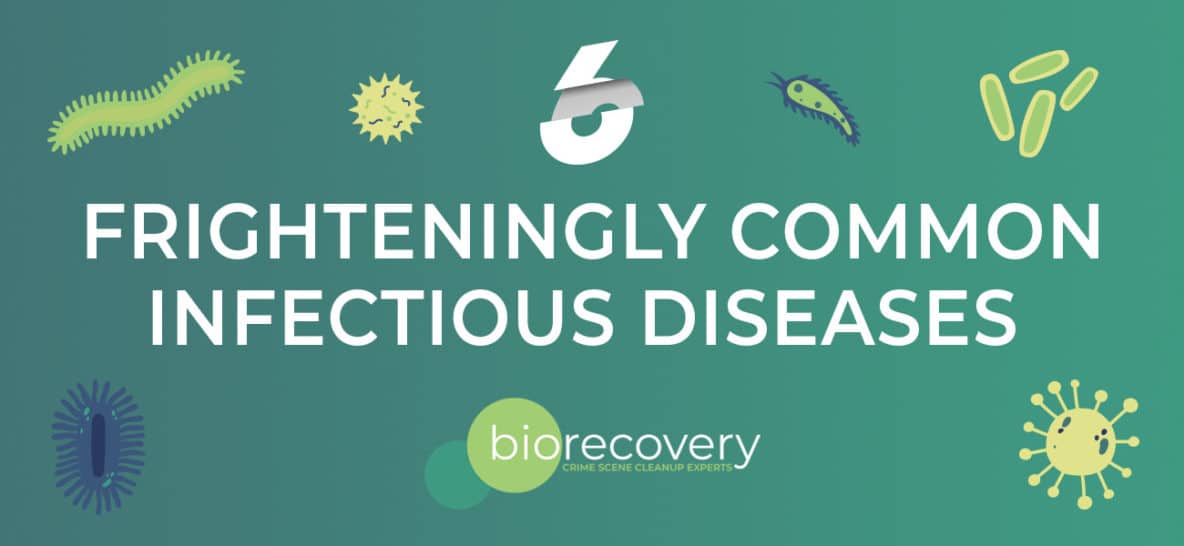Infectious diseases and superbug breakouts aren’t just the stuff of science fiction and dystopian movies. This summer, a record number of viewers binged National Geographic’s adaptation of the classic Ebola drama The Hot Zone, but that plus many other common infectious diseases are already here in North America, stacking up a higher and higher infection rate and death toll.
Fortunately, with proper infectious disease contamination, the following bacterial and viral diseases can be kept in check.
Here we’ll take a look at 6 of the most frighteningly common infectious diseases we are dealing with today. Some of these have experienced spikes in prevalence in the past, and some may just be on the verge of an all out breakout.
6 Common Infectious Diseases
The following infectious diseases are far more common that we realize:
1. Candida auris
The media is paying more attention to this emerging infectious disease, which is becoming a growing hazard in healthcare facilities. Candida auris is resistant to multiple treatments and equally difficult to identify and diagnose. It lives on skin, but it can survive on hard surfaces for weeks.
C. auris can colonize a person’s skin without causing the host to experience symptoms. Most people with C. auris colonies don’t experience symptoms, but that’s not necessarily a good thing—it’s easily spread, and those who aren’t aware they’ve got an infectious disease typically don’t take the additional precautions necessary to prevent contamination.
The fungus can infect the bloodstream and inhabit the gastrointestinal system, causing severe flu-like symptoms. People who are post-operative or who have weak immune systems are at the highest risk.
While the CDC is encouraging hospitals and nursing homes to test patients who may have come into contact with Candida auris, results may take weeks due to difficulties in identifying fungal spores.
2. Clostridioides difficile (C. diff)

The CDC reports that the C. diff bacterium infects a half million people each year, causing severe gastrointestinal pain, pervasive diarrhea, nausea, loss of appetite, and dehydration.
Undiagnosed C. diff can destroy the lower GI tract. C. diff contamination most often occurs among hospitalized patients, and the bacteria spreads through substandard decontamination and handwashing procedures. C. diff can live outside the human body and spread infection for five months.
C. diff is most deadly to senior citizens. One out of 11 people aged 65 or older die from C. diffcomplications, and among all ages, 20% of those previously infected will get it again.
3. Escherichia coli (E. coli)

We all have E. coli in our guts. That’s a fact, and one we shouldn’t worry about—the bacteria is an important part of our gut biosphere. But some strains, such as the Shiga toxin-producing E. coli(STEC), causes painful cramping, high fever, dizziness, and bloody diarrhea.
Some medications may cause the bacteria to produce the Shiga toxin which, in elevated quantities, can cause kidney damage so most physicians recommend “riding out” the infection with bed rest and plenty of fluids.
E. coli infections occur during oral contact with contaminated liquid, food, or objects. According to the CDC, other types of dangerous, diarrhea-causing E. coli include:
- Enterotoxigenic E. coli (ETEC)
- Enteropathogenic E. coli (EPEC)
- Enteroaggregative E. coli (EAEC)
- Enteroinvasive E. coli (EIEC)
- Diffusely adherent E. coli (DAEC)
Food processing plants are often the point of origin for E. coli outbreaks. Improper decontamination of surfaces and machinery and poor handwashing discipline have been blamed for illnesses traced back to produce and animal products.
Contact with untreated water, livestock, and traces of human feces on surfaces are other common means of contracting dangerous forms ofE. coli. Schools, daycare facilities, nursing homes, and medical centers often require extensive and rigorous infectious disease decontamination.
4. Hepatitis A, B, and C
There are four strains of the Hepatitis virus: A, B, C, and D, and E. The first three are the most serious and common of the four, threatening liver function. Hepatitis D and E are rarely encountered in the United States.
Hepatitis A (HAV)
Much like E. coli, hepatitis A is transmitted orally from contaminated objects, food, or water, particularly when feces is the source of contamination.
The World Health Organization (WHO) states, “Unlike hepatitis B and C, hepatitis A does not cause chronic liver disease and is rarely fatal, but it can cause debilitating symptoms and fulminant hepatitis (acute liver failure), which is often fatal.” Hepatitis A is a concern among food handlers, including restaurant workers.
Hepatitis B (HBV)
Hepatitis B is a bloodborne pathogen. According to the Hepatitis B Foundation, it’s one hundred times more infectious than HIV, the virus that causes AIDS. Up to 30 million people worldwide are infected with HBV each year by:
- Having unprotected sex
- Sharing needles used for drugs or tattoos
- Coming into contact with blood and other body fluids
- Contaminated food handled by
- Living with a person with HBV
Hepatitis B can live outside the body for up to seven days. There is a vaccine but no cure, and those infected with hepatitis B usually require lifetime treatments to suppress the virus and support their hepatitis-damaged livers.
Hepatitis C (HCV)
HCV is transmitted the same way as hepatitis B, with similarly severe liver damage. Hepatitis C is a major cause of liver cancer. While there is a vaccine for hepatitis B, there is none for HCV. According to WHO, more than 70 million people worldwide have chronic hepatitis C. A very small percentage of HCV patients only experience short-term (acute) effects.
Every strain of Hepatitis is disinfected differently, depending on the situation. Please see our hepatitis disinfection guidelines for what to do after suspected exposure.
5. Influenza
We as a society are starting to take the “old fashioned flu” seriously again. Eighty thousand Americans died from influenza in the 2017-2018 flu season—the highest tally in more than four decades.
Influenza vaccines must be reformulated annually to reflect the flu virus’ genetic changes, including those that happen slowly over time (antigenic drift) and those that occur suddenly (antigenic shift). While the vaccine doesn’t guarantee immunity, it can reduce symptoms and shorten their duration.
The flu virus can live on surfaces for up to two days.
6. Methicillin-Resistant Staphylococcus aureus (MRSA)
Methicillin-resistant Staphylococcus aureus (MRSA) bacteria that cause infections and sepsis in the respiratory system, bloodstream, and open wounds and abrasions.
As the name implies, it’s resistant to many antibiotics and is often spread in hospitals and nursing facilities. This means that the main way avoid this superbug is taking specific precautions proven to lower your risk of infection.
MRSA spreads by touch and can live on surfaces for several weeks. According to the University of Chicago’s MRSA Research Center, more than 20% of MRSA cases are fatal, and MRSA kills more people each year than AIDS.
Call Bio Recovery Today

If you are dealing with a possible infectious disease in your home, business, automobile, hospital, etc., give us a call today. Our representatives are on standby 24/7 at 1-888-752-5001.
We are fully prepared to perform top-down decontamination services for each disease listed above, as well as many others not included in this list.
Bio Recovery thoroughly sanitizes homes, medical facilities, businesses, schools, and institutions that have been contaminated by infectious disease. Call us if you’ve had an outbreak or you’re caring for an infected patient. In the meantime, practice proper hand-washing techniques and see a physician if you’re experiencing any of the above symptoms.
